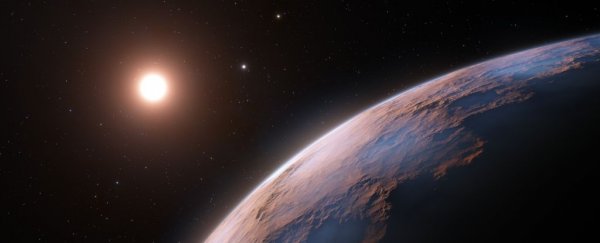What appears to be a teeny tiny alien world has just been found orbiting the Solar System's closest stellar neighbor.
The exoplanet candidate, named Proxima d, orbits a star named Proxima Centauri: a small, dim red dwarf star just 4.2 light-years from the Sun.
Amazingly, the exoplanet is just a quarter of the mass of Earth. That makes it one of the smallest exoplanets ever detected, and the smallest detected by observing the exoplanet's gravitational effect on its star.
The discovery also marks the third exoplanet found orbiting Proxima Centauri, and although the newly discovered world would not be habitable, its detection suggests that there's a whole wealth of exoplanets out there just outside the reach of our current capabilities.
"The discovery shows that our closest stellar neighbor seems to be packed with interesting new worlds, within reach of further study and future exploration," says astrophysicist João Faria of the Instituto de Astrofísica e Ciências do Espaço in Portugal.
To date, nearly 5,000 exoplanets (planets outside the Solar System) have been discovered and confirmed, and we have detections of thousands more candidate exoplanets.
We have two main ways for searching for these exoplanets. The most widely used technique is the transit method, in which a telescope observes stars for long periods of time to detect the faint, regular dips in brightness that signal an orbiting planet passing between us and the star.
The other most commonly used method is known as the radial velocity (or wobble) method. When two bodies, such as a star and a planet, are gravitationally bound, one doesn't orbit the other. Instead, they orbit their common center of mass; the Solar System's barycenter, for example, is just outside the Sun's surface.
This causes the star to 'wobble' slightly on the spot; in turn, that affects the light that reaches us, causing a Doppler shift. As the star moves away from us, the wavelengths of its light stretch out slightly; when it moves towards us, they compress. Astronomers can look for those regular Doppler shifts to infer the presence of an exoplanet.
Both of these methods are much better at detecting bigger exoplanets. A bigger exoplanet will block more light from the star, or produce a more pronounced stellar wobble. To date, and at time of writing, just 36 exoplanets of the 32,073 recorded on the Exoplanet Archive are less massive than Earth.
Hints of Proxima d emerged in 2020, when astronomers were using the Echelle SPectrograph for Rocky Exoplanets and Stable Spectroscopic Observations (ESPRESSO) instrument on ESO's Very Large Telescope to confirm another of Proxima Centauri's exoplanets.
They took radial velocity methods, and confirmed the existence of Proxima b, an exoplanet around 1.2 times the mass of Earth, on an 11.2-day orbit around the star.
But there was another, much fainter signal in the data. There seemed to be something orbiting the star on a five-day period. The signal was so faint, however, that more observations were required to try to work out if it was an external influence, or if the fluctuations in light were emanating from internal processes in the star itself.
It was, indeed, the team determined, an exoplanet; one so tiny that it was causing the star to move back and forth at just 40 centimeters (16 inches) per second. Being able to detect that ever-so-subtle motion from 4.2 light-years away is simply phenomenal.
"After obtaining new observations, we were able to confirm this signal as a new planet candidate," Faria said. "I was excited by the challenge of detecting such a small signal and, by doing so, discovering an exoplanet so close to Earth."
The exoplanet Proxima d is at least 0.26 times the mass of Earth, orbiting its star once every 5.12 days. That sadly means that it is too close to the star to be hospitable to life as we know it; even a cool red dwarf would give off too much heat to support liquid water on the surface of an exoplanet so close.
(The third planet orbiting Proxima Centauri is called Proxima c, approximately six times the mass of Earth, and on a 5.2-year orbit; too cold to be habitable. Proxima b is the best bet for habitability, but don't hold your breath.)
Nevertheless, the discovery suggests that the dearth of smaller exoplanets on the record so far could simply be a result of our existing inability to reliably detect them – and that finding them is simply going to be a matter of time and technology.
"This achievement is extremely important," says astronomer Pedro Figueira, ESPRESSO instrument scientist at ESO in Chile.
"It shows that the radial velocity technique has the potential to unveil a population of light planets, like our own, that are expected to be the most abundant in our galaxy and that can potentially host life as we know it."
The research has been published in Astronomy & Astrophysics.
